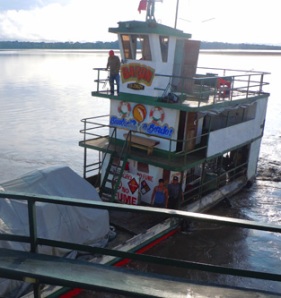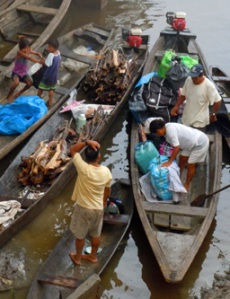June 25, 2102
While Yully and her husband Victor zipped off on his motorcycle to get a few last minute supplies, I wandered into the modestly appointed Bar La Rejita just outside the main gate to Puerto de Pescadores. My request for a small beer didn’t seem to compute with the waitress, so she just brought me a 650 ml (about 22 oz) bottle of Barena that was the cheapest (3 soles – about $1.15). To my right were three men engaged in animated conversation who filled and emptied their glasses in quick succession. I was more interested by a pair of fellows on my other side who shared one bottle, one glass and even fewer words. One man took periodic sips until the golden liquid was gone. He then poured the remaining suds back into the bottle and handed the glass to his mate across the table. When they moved onto their second bottle, they deposited their residual into the first. As the time for my lancha’s departure neared, I offered the remaining third of my bottle to this pair. Unable to contain my curiosity, I asked one of the men if their ritual had any particular meaning. He smiled and just said it was a custom between his friend and him.
Settled into our little cabin on the Lucho, Yully and I discussed how we wanted to handle the first set of “premios” (prizes) for artisans from Brillo Nuevo. We had encouraged these women to form their own quality control committee, but many of them didn’t like getting feedback on their work from artisans outside their family. Noting the community’s gusto for its competition for the best “juane” (a pyramidal shaped block of rice with meat and condiments), I had asked the group last summer if they would welcome prizes recognition for their craft making as a different kind of incentive for careful and creative work. Based on their enthusiastic response, I had prepared certificates for each artisan whose products had sold above a certain amount; Yully and I also decided to award prizes for distinction in sales, design, and cooperation. We also wanted to give one for conservation, but couldn’t yet define proper criteria for this category.After having some fried fish and platanos for dinner, Yully and I retreated to our bunks to listen to our MP3 players and drift to sleep expecting to arrive at Pebas sometime the next morning. Wandering onto deck around dawn I wondered why we were stopped far from the nearest bank with no settlement in sight. This answer was simple; we were grounded on a hidden mud bank. We in fact had run aground near the mouth of the Napo River around midnight only three hours after leaving port. The Amazon River is always a dynamic channel, but this year’s heavy flow contorted it more than usual. The spring rains hadn’t seemed particularly heavy. Many speculated the river’s swelling was due to greater snow melt in the Andes – perhaps due to a warming climate.
Another lancha eventually arrived to help dislodge us. The Baron was smaller and less powerful than ours, but its shallower draft at least made it less likely to getting stuck as well. After several hours of revving our engines and sideways pushes on our stern, the Lucho eased off the bank to deeper water. Yully and I used the ten hour delay to get some more work done on our laptops, but it might require compressing the rest of our itinerary. After passing by the series of little towns on the north bank of the Amazon, we finally got to Pebas just before sunset. We had originally hoped to make it to Brillo Nuevo that day, but knowing it wouldn’t be safe traveling so far up river in the dark, we transferred our big bags to the “hospedaje” (little hotel) just beyond the bridge to the floating dock. It only had one room available, so I packed up my toiletries and blanket to find lodging elsewhere. Yully advised against going back to Hostel Arcely where we had stayed in February since she had encountered a greater than usual number of rats there in her most recent visit. I got a basic but clean enough room at a place in the center of town. The only downside was that its common roof with a restaurant next door offered no barrier to the loud music, dancing, and other sounds of merriment emanating from its patrons celebrating the finale of the Festival of San Juan. I appreciated my hotel’s owner offer to move me to another room a few doors down the hall. Yully and I bought sundry food items to supplement our artisan prizes and then had dinner at the Polleria Cindy Alicia, our favorite (not quite the only) restaurant in Pebas named after the owners’ daughters. You get to choose either 1/8, 1/4, 1/2 or a full roasted chicken with your choice of either French fries, fried plantains or fried rice. The choice(s) of beverage tonight was Coke and ……Coke since they were out of the other Peruvian favorite Inca Cola (now also owned by the Coca-Cola company). Somewhat numb from our trip, Yully and I focused on our bird, dipped our potatoes in mayo and ketchup (quite sweet for my taste), and half-watched a dubbed version of Bourne Supremacy playing on the TV with Cindy and Alicia parked in front of the set.It felt good to lie down for the night once I found the right position to minimize feeling the wooden slats below the thin mattress. While a rooster had been my early morning nemesis at the Hostal Arecely, I woke up around 3 am this morning to the lustful calls of the hotel’s skinny orange and white tabby in heat. I dozed for an hour before conceding this round to the cat and got up to write and edit photos until dawn.
I made my way to my favorite juice bar run by a husband and wife couple at the public market. Breakfast consisted of a toasted egg sandwich and two tall glasses of a “jugo sortido” (mixed juice smoothie) that included fresh papaya, banana, pineapple, and orange. Bits of a beet gave it a deep pink color. While waiting for Yully to pick me up, I chatted with another couple across the aisle who sold game meat at their stall. I’ve seen large land turtles there before. This morning they were displaying organs, haunches, and legs of a jungle deer (mostly identified with the two-toed hoof) and a paca (medium large spotted rodent). Their young daughter periodically waved a stick with a bit of pink ribbon over the bloody hunks to shoo off the flies. Commerce in wild animals is technically illegal, but it provides an important source of income for many native men and is openly accepted in such places as well as the big market in Iquitos. Yully and Oscar, our local project coordinator from Brillo Nuevo, finished their errands so we carefully carted our bags down the steep steps and slippery mud flat to his motor-canoe where his wife Ena was waiting. She looked very tired, but her malaise had more to do with her slow recovery from a recent bout of malaria than lack of sleep. We had earlier bumped into another woman artisan from Brillo Nuevo, walking through Pebas whose face was so pale; her eyes also showed the fatigue of the debilitating disease. Ena and Amalia were far from alone.Another consequence of the prolonged river rise in the final months of this year’s rainy season was that virtually every village in the region had abnormally high and prolonged flooding. People living near the rivers almost always build their homes on stilts, but this year many moved to a second story if they had one or abandoned their houses altogether for higher ground if they didn’t. Many crops were wiped out to the extent that the federal government had to send in food aide to curb starvation. As the waters receded, the shallow ponds left in their wake around their homes created ideal breeding habitat for mosquitoes. Malaria reached epidemic proportions, and the rural health authorities were pushed to their limit doing blood tests and giving out pills to treat it.
Everyone agrees that are several important ways to reduce the risk of contracting malaria. These include trying to limit one’s exposure to mosquitoes – primarily by trying to stay protected during the few hours around dawn and dusk when they are most active and sleeping under some kind of netting at night. There is a major difference of opinion among health authorities, however, about the role of chemical prophylaxis. Travel clinics and doctors from the north firmly urge people going into areas with malaria to take one of several types of pills that supposedly make it difficult or impossible for the malaria parasite to survive in a person’s system. Doctors and many other people who live here, however, say that this type of prevention is counter-productive. They say that these pills in fact do not stop a person from contracting malaria if they are bitten by a mosquito carrying it. It only diminishes or masks the symptoms and actually makes it harder to definitively diagnose its presence. Consequently many people who take such pills get the parasite but only start to feel its effects some weeks after exposure. Taking the pills for a month after being in a high-risk area is supposed to deal with this concern, but there is still a sharp north-south split about this practice.
I don’t know which side is right, but if I know I’m going to be in an area where malaria is a moderate risk, I take the pills. I prefer not to go into an area where the risk is considered high. Some researchers seem to recount their bouts with malaria and other exotic tropical disease with some degree of pride. This is one kind of experience common to many in the Amazon and other tropical regions that I would be quite happy to never share.
We finally got underway in Oscar’s peque-peque just after 8 am and made a brief stop at Puca Urquillo to check in with FECONA – the native federation representing the 14 villages in the Ampiyacu region. In the past month, the river level had dropped considerably and its pull on water-saturated earth steadily erodes man-made structures. Yully, Ena and I had to climb up fractured cement steps barely suspended by exposed pieces of rebar. Several years ago, a whole section of the sidewalk leading into the village had collapsed into a mini-ravine.The FECONA president wasn’t around, but we left word with one of her colleagues that we would return in a week. Ena completed her mission of dropping off a bag of chambira fiber ready for weaving to a Bora friend.
We had a blessedly easy day of travel heading up the Yaguasyacu River to Brillo Nuevo. I put on sun screen and stretched out in the boat’s middle section. I sat comfortably on my folded fleece blanket, leaned against the padded back of my daypack, watched kingfishers darting about, and took in a collection of Stephen King stories through my MP3 player. I love the natural sounds of the jungle, but I prefer listening to a narrator telling a good story through earphones rather than soaking in the unrelenting roar of a diesel engine for five hours.









